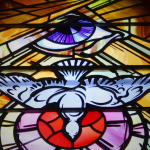And Abraham said to his servant, the oldest of his household, who had charge of all that he had, “Put your hand under my thigh, that I may make you swear by the Lord, the God of heaven and God of the earth, that you will not take a wife for my son from the daughters of the Canaanites, among whom I dwell, but will go to my country and to my kindred, and take a wife for my son Isaac.” Gen 24:2-4 (ESV)
“Put your hand under my thigh…?” My first thought, “you want me to do what?” “Wouldn’t a handshake do just as well?”
What is going on here and in Gen 47:29 is more than a gentlemen’s agreement between two parties. A handshake just won’t do. This is an oath before God. This would be akin to the familiar US Court scene where prior to testifying a person puts their hand on the bible. Perhaps a better analogy is when the US President takes the oath of office, putting their hand on the bible for the swearing in by the Supreme Court Justice. The idea is an oath before God. But then why the bible?
Oaths in the Bible and Jewish Text
The concept is the bible is being used much as the Torah (the Jewish Scrolls in ancient times) was used to represent the presence of God before whom the oath is being taken. But the bible or the Torah were not the only signifiers of the presence of God. Further, in the passages mentioned thus far, there would not have been any Torah as the events preceded it. So, why would a person’s thigh represent the presence of God? Well, it didn’t.
One scholar who wrote the clearest article I could locate on the subject when I first encountered the idiom was D.R. Freedman in his article “Put Your Hand Under My Thigh – the Patriarchal Oath.” He found that Jewish Rabbinic text (collected in volumes called the Talmud, a record of traditions) that the swearing of the oath was done with the circumcised membrane held in the oath-swearer’s hand. Personally, putting my hand under the guy’s thigh now seems not so bad. The oath in the presence of God required God’s presence. Since the creation of images of God was strictly forbidden, so there were none, something else had to be found. The only sign any person was provided by God is given in Genesis 17:9-11.
Circumcision as the Sign of the Covenant
And God said to Abraham, “As for you, you shall keep my covenant, you and your offspring after you throughout their generations. This is my covenant, which you shall keep, between me and you and your offspring after you: Every male among you shall be circumcised. You shall be circumcised in the flesh of your foreskins, and it shall be a sign of the covenant between me and you. Genesis 17:9–11 (ESV)
The representation of the covenant, God’s relationship and oath between him and his people, was through circumcision. Thus, the circumcised membrane was used. Unsavory perhaps as it was.
The swearing on some representation of the presence of the deity on which the oath was being pledged was not new and was brought forth from the Babylonian traditions of 1700 B.C.E.
Were other items used? I would say, “yes”. Another oath-reference might be found in Exodus 17:16, where Moses appears to be using the ‘throne of God’ (an alter) to make an oath:
And Moses built an altar and called the name of it, The Lord Is My Banner, saying, “A hand upon the throne of the Lord! The Lord will have war with Amalek from generation to generation.”
Oaths in the New Testament
Further, we can see this in the New Testament (NT) in a different form. After Jesus’ death, resurrection, and ascension he had promised to send the Holy Spirit, which he delivered on Pentecost. With the presence of God now being the Holy Spirit within ourselves, oaths need to be carefully considered. In Acts 5:1-11 a couple named Ananias and Sapphira learned this when they lied about the donation they had made. They had said it was all the profits from the sale of some of their land. Peter reveals to them that “You have not lied to man but to God.” As the oath in the presence of God was made and broken, they both ended up dying – not by the hands of men, but as a direct consequence of their broken oath. They simply dropped down dead.
So, “putting your hand under my thigh” would be a euphemism for holding the circumcised membrane in those times which was simply a method of acknowledging the presence of God as the binder of the oath.
Why does it matter?
Since the earliest of times in recorded human history the oath before God was one of grave seriousness. His acknowledged presence brought to the oath a truly grave and binding dedication. Now, with the presence of God dwelling within us, oaths should not be done lightly nor disregarded as easily as modern times takes them to be. Oaths of public service, of public office, of dedication to family, of dedication to a spouse, or to the service of a group should be carefully considered. Jesus himself provides a warning and advice on oath-taking in Mathew 5:33-37. Although in Matthew he is speaking more to humans developing a character of honesty within themselves, he nonetheless indicates that an oath to God carries with it a significance that we are in the modern world not always careful to consider. You might want to warn someone the next time you hear them say flippantly, “I swear to God….”, just so they know what they are really getting themselves into.
















